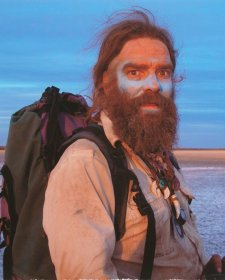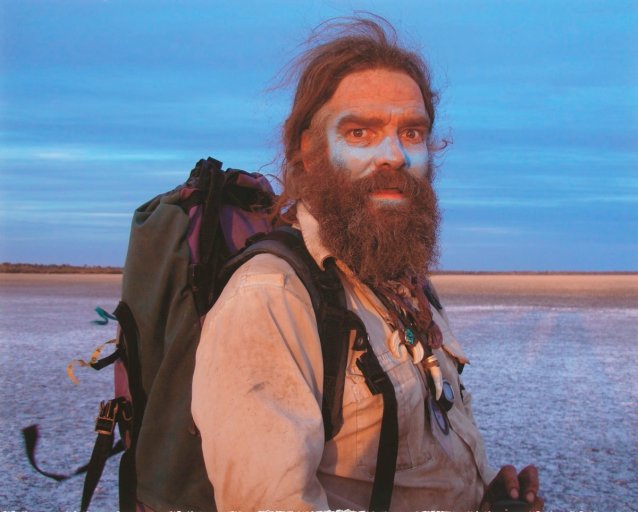Filmmaker Ian Darling talks with adventurer Jon Muir about crossing the vast salt lakes of central Australia.
So, I guess we should talk about the photo, and the photo's called Jon.
[Jon] Yeah, the photo is called Jon.
[Ian] It's interesting because you're, you'd be recognised as one of Australia's greatest adventurers and explorers, both living and dead. You happen to be living,
Oh yeah .
[Ian] But and that's a rarity in this game. But you know, you're a very private figure yet certainly in climbing circles and adventure circles, you know, you're seen as a bit of a guru or God in that area. What does it feel like when you walk in and you see your portrait hanging on the wall of the National Portrait Gallery?
Yeah, look, it's almost comical. Yeah, I get some mixture of emotions but, but maybe overriding it all with the comic.
[Ian] Yeah
Because I don't, that's not, I am simple man, and so, I just get out there and do my simple things. And climbing a mountain or walking across the desert, it's raw and simple and basic, and it sort of brings it home to me that , and then I read the bio. Yeah, yeah I did do all that stuff, didn't I? Yeah I'm sort of more focused on,
Yeah.
I've got to plant more potatoes next week.
[Jon] Jon here, yep it is. And I just like to say it's outrageous up on this glacier--
[Ian] We've made two documentaries together, where we've co-directed.
Yeah.
[Ian] so we first met when we were climbing Aconcagua, in South America and that was...
[John] Summer three, four.
[Jon and Ian] '93, '94
And then we've done a lot of walks together, out in the desert and pedalled.
[Jon] Kayaking.
Kayaking. and walked across dry salt lakes and all of that. And this actually was a dry salt lake.
Yeah.
It was Lake Amadeus. And we've been walking from Kings Canyon to Uluru. And so we've been, I guess we've been out there about a week haven't we?
Yeah, yeah. And that was that, that I love the way that eventuated was the salt lakes. It's just such magic places. And we arrived and we had the cross this lake, and it was about 15 kilometres across. It's a very long lake but, and we arrived in the middle of the day, remember that?
[Ian] Yeah.
And we, from previous experience we knew how surreal these places are and we also knew as a full moon rising that night. So we thought, "let's stop here and have a main meal lunchtime and have a rest, and then head out onto the lake."
[Ian] There's something really special about walking across dry salt lakes. And we've done a number of them there. Remember when we walked across Lake Frome, and we could see nothing. And we all thought it was like what it must be Antarctica. And we're calling the salt, the ice.
Yes.
And that was, that was that feeling we got out and we just suddenly felt so free. You we're not going to bump into a single thing. But it was winter, and you know, as, with my documentary-filmmaker hat on, I knew that it was going to be, a magical hour. Taking that, that I've probably taken three or four or five photos but the second I took that photo, I knew I'd captured something pretty special. And you know, we call the truth but that was, that was your truth. You were there and that was you, in your zone, when you're absolutely at your happiest.
Yeah.
And there was something so magical taking it, I just went," I've got it!". I remember even showing you, I said "I've never taken a photo like this, of you." and there's so many that I think captured it but that was just that moment.
[Jon] Yeah.
Just this, bomb went off in my head.
Yeah.
[Ian] It was just so exciting.
[Jon] I know I got really charged, energised, by the beauty around us, by that raw, unpeopled. No evidence of anyone except us, there, on the whole walk I didn't think we saw any but yeah, so yeah, you're right. I was totally, totally in my favourite place to be .
One of the things that is interesting when people are looking at it too, and wouldn't have been conscious is, you know, because we're spending so much time in the sun, we've always used to put a lot of zinc cream on. And for you, sometimes you put pink on, sometimes it's yellow or orange.
[Jon] Yeah.
[Ian] But that day you just happen to put on this colour, and you're just you're just blending in and, and some may think that was forced. But it was just, you know, you put it on earlier that morning,
Yeah
we didn't know where we were gonna be.
Yeah
And we hadn't seen that colour, until that moment that night.
Yeah
Shades of it. I thought that was quite interesting too. In many ways that photo sort of shows you at one with the environment. 'Cause you've almost just melted into it, or camouflaged.
Yes
And that's, that's what you were, and I think that was a big observation when when we made that film together, you know. You were out there solo for 128 days. And it was just you, just melting into the environment, no-one knew where you were, what you were doing.
[Jon] Yeah, and it was delicious.
The first time it had been seen publicly was in the National Portrait Gallery's photo prize.
[Jon] Yes.
And I think that was 2008 or nine or something.
Yeah, yeah.
[Ian] And there's sort of sometimes you know, photographer's vanity going, "Oh I'll have to have a huge photo." but this needed to show that the scale, sort of you but the enormity of the landscape and I sort of felt that night, you were bigger than the landscape.
[Jon] Right.
and to reflect that, you know
Yeah it a needed, needed a sense of scale.
Yeah, right. I mean, in that situation, I just feel so, I feel
so, complete the opposite.
Not, not smaller but just this small part of the, the big, the big whole.
[Ian] Yeah.
And when I'm in nature, and in the wild, that's, that's one of the things I go out there for, is that incredible, strong sense of that. As I said earlier, it's where my heart and soul are most satisfied, just out in the wild.
Related information



Roam alone
About Face article4 May 2020
Jon Muir, adventurer and Portrait Gallery Collection subject, really knows about isolation.



The Gallery
Visit us, learn with us, support us or work with us! Here’s a range of information about planning your visit, our history and more!



Support your Portrait Gallery
We depend on your support to keep creating our programs, exhibitions, publications and building the amazing portrait collection!





